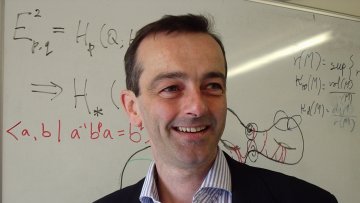Geometric Fusion via Joint Delay Embeddings
Abstract
This talk is motivated by the following question: "how can one reconstruct the geometry of a state space given a collection of observed time series?" A well-studied technique for metric fusion is Similarity Network Fusion (SNF), which works by mixing random walks. However, SNF behaves poorly in the presence of correlated noise, and always reconstructs an intrinsic metric. We propose a new methodology based on delay embeddings, together with a simple orthogonalization scheme that uses the tangency data contained in delay vectors. This method shows promising results for some synthetic and real-world data. The authors suspect that there is a theorem or two hiding in the background -- wild speculation by audience members is encouraged.
Oxford Mathematician Bryan Birch has been awarded the Royal Society's Sylvester Medal for 2020 for his work in driving the theory of elliptic curves through the Birch--Swinnerton-Dyer conjecture and the theory of Heegner points.
Invariants for tame parametrised chain complexes
Abstract
Persistence theory provides useful tools to extract information from real-world data sets, and profits of techniques from different mathematical disciplines, such as Morse theory and quiver representation. In this seminar, I am going to present a new approach for studying persistence theory using model categories. I will briefly introduce model categories and then describe how to define a model structure on the category of the tame parametrised chain complexes, which are chain complexes that evolve in time. Using this model structure, we can define new invariants for tame parametrised chain complexes, which are in perfect accordance with the standard barcode when restricting to persistence modules. I will illustrate with some examples why such an approach can be useful in topological data analysis and what new insight on standard persistence can give us.
Oxford Mathematicians Martin Bridson and Endre Suli have been elected to Academia Europaea.
Oxford Mathematics Online Public Lecture: David Sumpter - How Learning Ten Equations Can Improve Your Life
Is there a secret formula for becoming rich? Or for happiness? Or for becoming popular? Or for self-confidence and good judgement? David Sumpter answer these questions with an emphatic ‘Yes!' All YOU need are The Ten Equations.
In this lecture David will reveal three of these: the confidence equation that helps gamblers know when they have a winning strategy; the influencer equation that shapes our social interactions; and the learning equation that YouTube used to get us addicted to their videos. A small group of mathematicians have used these equations to revolutionise our world. Now you can use them too to better manage your time and make money, have a more balanced approach to your popularity and even to become a nicer person.
To order the book 'The Ten Equations That Rule the World' signed by David Sumpter from Blackwell's Bookshop, email @email by 15 November and they will provide you with all the information you need.
David Sumpter is Professor of Applied Mathematics at the University of Uppsala, Sweden.
Watch online (no need to register):
Oxford Mathematics Twitter
Oxford Mathematics Facebook
Oxford Mathematics Livestream
Oxford Mathematics YouTube
The Oxford Mathematics Public Lectures are generously supported by XTX Markets.
[[{"fid":"59746","view_mode":"media_square","fields":{"format":"media_square","field_file_image_alt_text[und][0][value]":false,"field_file_image_title_text[und][0][value]":false},"type":"media","field_deltas":{"1":{"format":"media_square","field_file_image_alt_text[und][0][value]":false,"field_file_image_title_text[und][0][value]":false}},"attributes":{"class":"media-element file-media-square","data-delta":"1"}}]]
Oxford Mathematics Online Public Lecture: Tim Harford - How to Make the World Add up
When was the last time you read a grand statement, accompanied by a large number, and wondered whether it could really be true?
Statistics are vital in helping us tell stories – we see them in the papers, on social media, and we hear them used in everyday conversation – and yet we doubt them more than ever. But numbers, in the right hands, have the power to change the world for the better. Contrary to popular belief, good statistics are not a trick, although they are a kind of magic. Good statistics are like a telescope for an astronomer, or a microscope for a bacteriologist. If we are willing to let them, good statistics help us see things about the world around us and about ourselves.
Tim Harford is a senior columnist for the Financial Times, the presenter of Radio 4’s More or Less and is a visiting fellow at Nuffield College, Oxford. His books include The Fifty Things that Made the Modern Economy, Messy, and The Undercover Economist.
To order a personalised copy of Tim's book email @email, providing your name and contact phone number/email and the personalisation you would like. You can then pick up from 16/10 or contact Blackwell's on 01865 792792 from that date to pay and have it sent.
Watch online (no need to register):
Oxford Mathematics Twitter
Oxford Mathematics Facebook
Oxford Mathematics Livestream
Oxford Mathematics YouTube
The Oxford Mathematics Public Lectures are generously supported by XTX Markets.
Differentiating Lychees and Grapes
Abstract
Distinguishing classes of surfaces in $\mathbb{R}^n$ is a task which arises in many situations. There are many characteristics we can use to solve this classification problem. The Persistent Homology Transform allows us to look at shapes in $\mathbb{R}^n$ from $S^{n-1}$ directions simultaneously, and is a useful tool for surface classification. Using the Julia package DiscretePersistentHomologyTransform, we will look at some example curves in $\mathbb{R}^2$ and examine distinguishing features.
Noisy neurons and rainbow worms: theoretical and statistical perspectives on trees and their barcodes
Abstract
The TMD algorithm (Kanari et al. 2018) computes the barcode of a neuron (tree) with respect to the radial or path distance from the soma (root). We are interested in the inverse problem: how to understand the space of trees that are represented by the same barcode. Our tool to study this spaces is the stochastic TNS algorithm (Kanari et al. 2020) which generates trees from a given barcode in a biologically meaningful way.
I will present some theoretical results on the space of trees that have the same barcode, as well as the effect of adding noise to the barcode. In addition, I will provide a more combinatorial perspective on the space of barcodes, expressed in terms of the symmetric group. I will illustrate these results with experiments based on the TNS.
This is joint work with L. Kanari and K. Hess.




